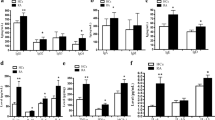Abstract
The aim of this study was to determine the activation level of the pro-inflammatory transcription factor nuclear factor κB (NF-κB) in lymphocytes of patients with rheumatoid arthritis (RA) before and during an anti-tumor necrosis factor α (TNFα) therapy (adalimumab). In addition, we analyzed the inflammatory markers, interleukin 6 (IL-6), and C-reactive protein (CRP) and investigated the expression of rheumatoid factor (RF) and anti-cyclic citrullinated peptide (anti-CCP) autoantibodies in patients’ sera. Twenty RA patients and 20 control subjects were investigated. RA patients’ characteristics were evaluated by radiography and disease activity score 28 (DAS 28). Twelve weeks of adalimumab therapy was effective in the treatment of RA patients, as shown by a significant improvement of the DAS 28. The inflammatory markers IL-6 and CRP were significantly different in sera of RA patients compared to the control group before the onset of therapy and exhibited a tendency to return to normal levels during the first 12 weeks of therapy. We measured a comparable activation level of NF-κB in lymphocytes of control subjects and of RA patients before starting adalimumab therapy. During the following 12 weeks, no significant changes in the activation levels of both NF-κB subunits were detected. Serum concentration of RF was significantly lower after 12 weeks, whereas anti-CCP antibody level remained constant.



Similar content being viewed by others
References
Silman AJ, Pearson JE (2002) Epidemiology and genetics of rheumatoid arthritis. Arthritis Res 4(Suppl 3):8265–8272
Marrack P, Kappler J, Kotzin BL (2001) Autoimmune disease: why and where it occurs. Nat Med 7:899–905
Lorenz HM, Kalden JR (2002) Perspectives for TNF-alpha-targeting therapies. Arthritis Res 4(Suppl 3):S17–S24
Weaver AL (2004) The impact of new biologicals in the treatment of rheumatoid arthritis. Rheumatology 43(Suppl 3):iii17–iii23
Pahl HL (1999) Activators and target genes of Rel/NF-kappaB transcription factors. Oncogene 18:6853–6866
Palanki MS (2002) Inhibitors of AP-1 and NF-kappa B mediated transcriptional activation: therapeutic potential in autoimmune diseases and structural diversity. Curr Med Chem 9:219–227
Eggert M, Kluter A, Zettl UK, Neeck G (2004) Transcription factors in autoimmune diseases. Curr Pharm Des 10:2787–2796
Eggert M, Kluter A, Rusch D, Schmidt KL, Dotzlaw H, Schulz M, Pabst W, Boke J, Renkawitz R, Neeck G (2002) Expression analysis of the glucocorticoid receptor and the nuclear factor-kB subunit p50 in lymphocytes from patients with rheumatoid arthritis. J Rheumatol 29:2500–2506
Baeuerle PA, Henkel T (1994) Function and activation of NF-kappa B in the immune system. Annu Rev Immunol 12:141–179
Bacher S, Schmitz ML (2004) The NF-kappaB pathway as a potential target for autoimmune disease therapy. Curr Pharm Des 10:2827–2837
Arnett FC, Edworthy SM, Bloch D, McShane DJ, Fries JF, Cooper NS, Healey LA, Kaplan SR, Liang MH, Luthra HS et al (1988) The American Rheumatism Association 1987 revised criteria for the classification of rheumatoid arthritis. Arthritis Rheum 31:315–324
Prevoo ML, van’t Hof MA, Kuper HH, van Leeuwen MA, van de Putte LB, van Riel PL (1995) Modified disease activity scores that include twenty-eight-joint counts. Development and validation in a prospective longitudinal study of patients with rheumatoid arthritis. Arthritis Rheum 38:44–48
Herbert JR, Waternaux C (1983) Graphical displays of growth data. Am J Clin Nutr 38:145–147
Furst DE, Schiff MH, Fleischmann RM, Strand V, Birbara CA, Compagnone D, Fischkoff SA, Chartash EK (2003) Adalimumab, a fully human anti tumor necrosis factor-alpha monoclonal antibody, and concomitant standard antirheumatic therapy for the treatment of rheumatoid arthritis: result of STAR (safety trial of adalimumab in rheumatoid arthritis). J Rheumatol 30:2563–2571
van de Putte LB, Atkins C, Malaise M, Sany J, Russell AS, van Riel PL, Settas L, Bijlsma JW, Todesco S, Dougados M, Nash P, Emery P, Walter N, Kaul M, Fischkoff S, Kupper H (2004) Efficacy and safety of adalimumab as monotherapy in patients with rheumatoid arthritis for whom previous disease modifying antirheumatic drug treatment has failed. Ann Rheum Dis 63:508–516
Keystone EC, Kavanaugh AF, Sharp JT, Tannenbaum H, Hua Y, Teoh LS, Fischkoff SA, Chartash EK (2004) Radiographic, clinical, and functional outcomes of treatment with adalimumab (a human anti-tumor necrosis factor monoclonal antibody) in patients with active rheumatoid arthritis receiving concomitant methotrexate therapy: a randomized, placebo-controlled, 52-week trial. Arthritis Rheum 50:1400–1411
Popa C, Netea MG, Radstake TR, van Riel PL, Barrera P, van der Meer JW (2005) Markers of inflammation are negatively correlated with serum leptin in rheumatoid arthritis. Ann Rheum Dis 64:1195–1198
Zikou AK, Argyropoulou MI, Voulgari PV, Xydis VG, Nikas SN, Efremidis SC, Drosos AA (2006) Magnetic resonance imaging quantification of hand synovitis in patients with rheumatoid arthritis treated with adalimumab. J Rheumatol 33:219–223
Atzeni F, Sarzi-Puttini P, Dell’ Acqua D, de Portu S, Cecchini G, Cruini C, Carrabba M, Meroni PL (2005) Adalimumab clinical efficacy is associated with rheumatoid factor and anti-cyclic citrullinated peptide antibody titer reduction: a one year prospective study. Arthritis Res Ther 8:R3
Yazdani-Biuki B, Stadlmaier E, Mulabecirovic A, Brezinschek R, Tilz G, Demel U, Mueller T, Brickmann K, Graninger WB, Brezinschek HP (2005) Blockade of tumour necrosis factor {alpha} significantly alters the serum level of IgG- and IgA-rheumatoid factor in patients with rheumatoid arthritis. Ann Rheum Dis 64:1224–1226
Alessandri C, Bombardieri M, Papa N, Cinquini M, Magrini L, Tincani A, Valesini G (2004) Decrease of anti-cyclic citrullinated peptide antibodies and rheumatic factor following anti TNFα therapy (infliximab) in rheumatoid arthritis is associated with clinical improvement. Ann Rheum Dis 63:1218–1221
Author information
Authors and Affiliations
Corresponding author
Rights and permissions
About this article
Cite this article
Semmler, M., Seeck, U., Neustadt, B. et al. No effects of adalimumab therapy on the activation of NF-κB in lymphocytes from patients with severe rheumatoid arthritis. Clin Rheumatol 26, 1499–1504 (2007). https://doi.org/10.1007/s10067-007-0540-2
Received:
Revised:
Accepted:
Published:
Issue Date:
DOI: https://doi.org/10.1007/s10067-007-0540-2




